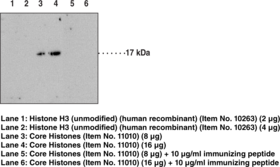Description
Histones are nuclear proteins that are responsible for the nucleosome structure of the chromosomal fiber in eukaryotes. The basic structure is a 146 bp strand of DNA wrapped around a histone octamer containing pairs of the four core histones (H2A, H2B, H3, and H4). Histones are subjected to numerous post-translational modifications including methylation. Histone lysine methylation is an important post-translational modification linked to diverse biological pathways including gene transcription, heterochromatin maintenance, and double-stranded DNA break repair.{20250} Most lysine methylation events are carried out by a SET domain-containing HMTase, and methylation at lysine 4 of histone 3 (H3K4) is an evolutionarily conserved modification associated with transcriptionally active chromatin.{19551,20252} The SET1/MLL (KMT2) family of methyltransferases is the principal enzyme family responsible for H3K4 methylations.{19551,19556} The WDR5/RbBP5/Ash21/DPY-30 subcomplex is required for the H3K4 dimethylation activity of the MLL1 core complex.{20268} Cayman’s Histone H3K4Me2 Monoclonal Antibody detects dimethylated histone H3 and does not detect unmodified histone H3.
Synonyms: Histone H3 containing dimethylated lysine 4
Immunogen: Synthetic peptide from the N terminal region of human Histone H3 (di-methyl K4) conjugated to KLH.
Formulation: 100 µg of protein G-purified antibody
Isotype: IgG2aκ
Applications: FC and WB
Origin:
Stability: 730 days
Application|Flow Cytometry||Application|Western Blot||Product Type|Antibodies|Monoclonal Antibodies||Research Area|Epigenetics, Transcription, & Translation|Histones/Histone Peptides|Acetylated||Research Area|Epigenetics, Transcription, & Translation|Histones/Histone Peptides|Methylated||Research Area|Epigenetics, Transcription, & Translation|Writers|Histone Acetylation||Research Area|Epigenetics, Transcription, & Translation|Writers|Histone Methylation




